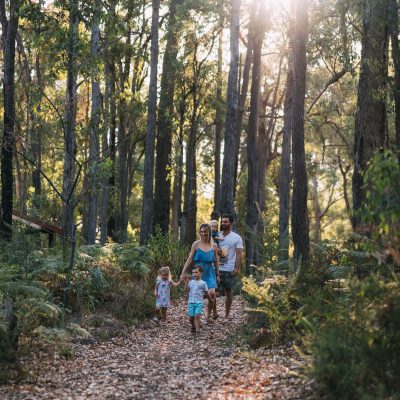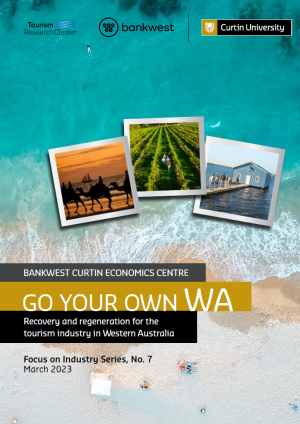Cultural tourism, international marketing and housing affordability key to revival of WA tourism sector

— Diversified and unique visitor experiences will drive a sustainable tourism strategy for WA —
— WA recapturing high-spend international visitors crucial to sector recovery —
— Housing affordability and labour shortages impacting regional tourism —
— Regional residents recognise both the benefits and the costs of tourism —
Released today by the Bankwest Curtin Economics Centre and the Tourism Research Cluster at Curtin University, the ‘Go Your Own WA: Recovery and regeneration for the tourism industry in Western Australia’ report has found Western Australia’s tourism industry continues to bounce back from a pandemic-induced slump, but still faces challenges such as realising the potential of cultural tourism, re-engagement with the important Chinese market and workforce shortages in regional tourism areas.
In 2020-21 the economic contribution of tourism in WA fell to $6.7 billion, which was 45 per cent below the peak 2018-2019 level of $12 billion. While tourist arrivals and expenditure trends have been resurgent since borders reopened in March 2022, the report found more needs to be done to realise the state’s tourism potential.
Co-author Dr Daniel Kiely from the Bankwest Curtin Economics Centre said while overall spending in WA has increased since borders opened, in general there has been a decline in short term international visitor arrivals.
“Re-engagement with high-expenditure international tourist markets is one key to revitalising the sector in WA. Pre-pandemic figures show China was a top-five source country for overseas visitors, accounting for 6.9 per cent of tourists, but did not feature in the top 10 source countries for short-term arrivals into WA in December 2022,” Dr Kiely said.
“We found global uncertainties and the rate at which international borders have reopened continue to impact the state’s international tourism sector. Analysis of trends in international tourist visits also found it is essential that WA continues to strive to achieve a proportionate share of international students travelling to Australia.”
A key solution to this problem has been found through novel modelling of data on internet search intensity as a proxy for the potential interest from international travellers in visiting WA.
“The report shows that an increase of 50 per cent in Google search volumes translate to an additional 130,000 visitors and half a billion dollars in extra tourism spending to the state each year,” Dr Kiely said.
“The benefits to the WA economy from marketing Western Australia as a tourism destination are substantial. Campaigns such as the recent Walking on a Dream and the recent video collaboration between Tourism Western Australia and our Eurovision song contest entrant Voyager promote Western Australia as a tourism destination very well.”
Co-author Associate Professor Michael Volgger from Curtin’s Tourism Research Cluster said that Western Australia has the climate, a diversity in environment and pristine natural settings with unique flora and fauna to support globally unique tourism experiences.
“WA should capitalise on its unique features to offer distinctive tourist experiences that offer cultural engagement and experiential tourism activities, such as Aboriginal tourism experiences, agritourism or even industrial tourism,” Associate Professor Volgger said.
“Cultural tourism should be supported across all the state’s regional areas, including major regional centres. But for this to be feasible, cultural exchange should be grounded in local cultural customs and practice but should happen alongside a broader agenda to improve the services, economic opportunities, health and living standards of people in remote communities.”
“Traditional owners should be closely involved in the development of Aboriginal tourism in regional areas, with consideration of cultural tourism options and opportunities such as more festivals that deepen visitors’ understanding of the culture, traditions and worldview of local First Nations peoples and affordable tours and walking trails that focus on native flora and fauna, led by Indigenous knowledge holders as guides.”
Also recommended was the integration of Indigenous perspectives into science tourism and nature-based tourism, as well as the construction of world-class tourist attractions, cultural centres and educational precincts that draw on the state’s unique Indigenous culture and history.
The insights of regional residents were also measured for the report through a tourism resident survey which asked people living across all five regions in WA a series of questions relating to their perception of the impact of tourism on their region.
Associate Professor Volgger said the survey identified the link between housing affordability and labour shortages as a critical factor affecting tourism.
“Housing affordability is also seen by residents and stakeholders as a key influence impacting labour shortages across the regions. The shortage of staff is in turn impacting visitor experiences and has the potential to damage the WA brand marketed both domestically and abroad,” Dr Volgger said.
“Housing, investment in regional areas and workforce issues need to be addressed as a priority with relevant strategies to ensure a motivated and skilled workforce is available and are attracted to the regions across WA, including access to visas for working holiday makers.”
“The tourism resident survey highlights that residents have a sophisticated perception of tourism, with many identifying both positive and negative impacts of tourism to their regions.”
“Housing prices and rental costs as well as the cost of land and the cost of goods and services were highlighted among the negative impacts from tourism, and unsurprisingly, these were most keenly felt during peak tourism periods,” Associate Professor Volgger said.
But Associate Professor Volgger said many of the same survey respondents recognised a wide range of economic and amenity-related benefits of tourism to their areas.
“Around 83 per cent of residents surveyed in Perth and a similar share of survey respondents in the South West believe that tourism makes an important economic contribution to their region, with nearly three quarters of respondents agreeing that tourism created more jobs,” Associate Professor Volgger said.
Key findings:
Trends in domestic travel
- Domestic travel accounted for 97.1 per cent of overall trips in WA (97.5% for Australia) and accounts for 82.5 per cent of overall tourism expenditure (76.8% for Australia) in 2018-19.
- In 2020-21, WA’s domestic tourism expenditure was down 13.7% on 2018-19. This compares well to other states, with a decline of 46.8% for Victoria, 21.3% for NSW, and 21.9% for QLD over the same period.
- As of June 2022, domestic overnight visitors in WA were just 7.6% below 2018-19 levels, while overnight trips to NSW and VIC remained some 33% below 2018-19 levels, with SA down 19% and QLD down 14% on 2018-19.
- Domestic overnight tourism expenditure in WA declined by 16.9% in the first year of the pandemic and by the end of June 2022 remained 12.5% below 2018-19 levels.
- Nationally the most cited reason for tourism travel in 2018-19 was for a holiday (39%), followed by visiting relatives and friends (33%) and business-related travel (22%).
- The most common form of visitor accommodation used across the states is in a family or relatives’ property. This is followed by hotels/resorts and caravan parks.
Trends in international tourist visits
- There were 8.6 million visitor trips to Australia in 2018-19 with 973,800 trips to WA, a peak year both nationally and for the state. Total tourism spending by international visitors to WA equalled $2.63B in 2018-19, some 7.4% of the overall national tourism related expenditure ($35.4B).
- WA had a 13.6% share of international trips to Australia in 2010-11, but fell to 11.3% by 2018-19.
- In 2018-19 over 15% of visitor trips to Australia came from China. Visitors from China comprised 6.9% of visitors to WA.
- The top source countries for visitors to WA included the UK (15%) followed by Singapore (10.7%), Malaysia (10.2%), New Zealand (7.5%) and China (6.9%).
- International visits from China to WA increased by a massive 228% between 2010-11 and 2018-19. Meanwhile, they grew by “just” 180% nationally.
Tourism’s economic contribution
- The value-added contribution of the tourism industry to the Australian economy was $60B for 2020-21. This is half of that reported in 2018-19 ($121B).
- VIC observed the largest decline in tourism value (-65%), with more significant border closures impacting domestic tourism within the state.
- The WA tourism industry contributed $12B to the WA economy in 2018-19 but as of 2020-21 was 45% below that level, sitting at $6.7B.
- Perth is the region with the largest tourism GVA at around $1.75B, followed by the Southwest ($800m) which produces around 45% of Perth’s GVA. The Northwest and the Coral Coast have similar tourism figures at $360m and $330m respectively.
COVID-19 effect on regional tourism
- WA lost close to 45% of tourism related GVA due to a decline in direct tourism activities between 2018-19 and 2020-21.
- Perth (-54.5%) and the Northwest (-43.3%) were more affected by the WA border closure.
- Perth observed a decline in total tourism related consumption expenditure of 57% between 2018-19 and 2020-21.
Employment contribution of tourism
- WA employed 56,310 people in tourism activities in 2020-21, down 15.5% from 2018-19 (66,605).
- Regions such as the Coral Coast (+23.6%) and the Southwest (+18.8%) observed increases in the number of people employed in tourism between 2019-19 and 2020-21
- Destination Perth saw a decline of 13,700 people (-35%) in tourism related employment between 2018-19 and 2020-21.
Composition of the labour force
- Between 2016 and 2021, there has been a decline in the share of migrants working in tourism sectors such as cafes, restaurants and takeaway food services as well as in accommodation services.
- The number of students entering the country has risen and we are now quite close to the influx levels that we had pre-pandemic, but WA is yet to catch up with the rest of Australia possibly due to the delayed border opening.
- In WA, the number of working holiday visa holders has been steadily declining since 2012-13 aligning with the end of the mining boom.
Using big data to inform public policy in tourism
- The worldwide internet search volumes for Perth currently are 77 per cent of the search volumes prior to the COVID-19 pandemic.
- On average, a 50 per cent increase in worldwide internet search intensity about travel to WA will lead to an increase of around 130,000 visitors in the following year.
- If internet search intensity related to travel to WA increases by 50 per cent in Singapore, we expect visitors to increase by about 27,000 over that year.





